Sebastiano del Piombo
Sebastiano del Piombo | |
|---|---|
 Copy ofThe Violinist,sometimes claimed to be a self portrait | |
| Born | Sebastiano Luciani c. 1485 ProbablyVenice,Italy |
| Died | 21 June 1547 (aged 61–62) Rome,Papal States |
| Education | Giovanni Bellini,probablyGiorgione |
| Known for | Painting |
| Movement | High Renaissance |
Sebastiano del Piombo(Italian:[sebaˈstjaːnodelˈpjombo];c. 1485– 21 June 1547) was an Italian painter of theHigh Renaissanceand earlyManneristperiods famous as the only major artist of the period to combine the colouring of theVenetian schoolin which he was trained with the monumental forms of the Roman school. He belongs both to the painting school of his native city, Venice, where he made significant contributions before he left for Rome in 1511, and that of Rome, where he stayed for the rest of his life, and whose style he thoroughly adopted.[1]
BornSebastiano Luciani,after coming to Rome he became known asSebastiano VenezianoorViniziano( "Sebastian the Venetian" ), until in 1531 he became theKeeper of the Seal to the Papacy,and so got the nicknamedel Piombo( "of theLead") thereafter, from his new job title ofpiombatore.[2]Friends like Michelangelo andAriostocalled himFra Bastiano( "Brother Bastian" ).[3]
Never a very disciplined or productive painter, his artistic productivity fell still further after becomingpiombatore,which committed him to attend on the pope most days, to travel with him and to take holy orders as afriar,despite having a wife and two children.[4]He now painted mostly portraits, and relatively few works of his survive compared to his great contemporaries in Rome. This limited his involvement with theManneriststyle of his later years.
Having achieved success as alutenistinVenicewhen young, he turned to painting and trained withGiovanni BelliniandGiorgione.When he first went to Rome he worked alongsideRaphaeland then became one of the few painters to get on well withMichelangelo,who tried to promote his career by encouraging him to compete for commissions against Raphael. He painted portraits and religious subjects in oils, and once he was established avoided the largefrescoschemes that took up so much of the time of Raphael and Michelangelo. His earlier career in both Venice and Rome was somewhat overshadowed by the presence of clearly greater painters in the same city, but after the death of Raphael in 1520 he became Rome's leading painter. His influence on other artists was limited by his lack of prominent pupils, and relatively little dissemination of his works inprintcopies.
Venice
[edit]
Sebastiano del Piombo was probably born in Venice, though there is no certainty as to his background. His birthdate is extrapolated fromVasari's statement that he was 62 at his death in 1547.[5]That he was first known as a musician and singer may suggest an upper-middle-class background; the extent to which his playing on theluteand other instruments was professional is unclear.[6]Like his contemporaryRaphael,his career was marked by his ability to get on well with both other artists and patrons. He began to train as a painter at a relatively late age, probably 18 or 20, so around 1503–05, becoming a pupil ofGiovanni Belliniand probably afterwards ofGiorgione,both of whose influence is apparent in his works;[4]Vasari's mention of their relationship is rather vague: "si acconciò con Giorgione".[7]
No signed or firmly documented works survive from his period painting in Venice, and many attributions are disputed.[4]As with other artists, some of Sebastiano's works have long been confused with Giorgione's. LikeTitian,he may have completed work left unfinished at Giorgione's death in 1510;Marcantonio Michielsays he finishedThe Three Philosophers.[8]The earliest significant work attributed to him is a portrait of a girl inBudapest,of about 1505.

He is now usually assigned the unfinished and reworkedJudgement of Solomonnow atKingston Lacy.This dramatic and imposing picture, "one of the masterpieces of Venetian narrative painting", was also long attributed to Giorgione; it may have been abandoned about 1508, though the estimated dates vary in the period 1505–1510. After extensive restoration in the 1980s, removing later overpainting, the painting is now left with traces of the three different compositions visible; still more can be seen withinfra-red reflectography.Still over 2 × 3 metres, it seems originally to have been even larger, with some 40 cm lost along the left edge. There are two versions of the elaborate architectural background, which was a recurrent interest of Sebastiano's Venetian period. The last setting is in abasilica,which may reflect a "more learned" picture intended for a building holding courts of justice. The figure at the front of the executioner, left without clothes or the baby, is clearly drawn from classical sculpture.[9]
Four standing figures of saints in niches on the organ-shutters ofSan Bartolomeo, Venice,now in theGallerie dell'Accademiain Venice, date fromc. 1508–09, and are "very Giorgionesque", especially the pair on the insides. They were painted at the same time as Giorgione's frescos for the Fondaco dei Tedeschi (now lost) just by the church, which was the German's church in Venice, and at this time also heldAlbrecht Dürer'sMadonna of the Rose-Garlandsof 1506. The outside pair of shutters also show what Sebastiano had learnt from Bellini.[10]Their technique has developed "from the earlier smooth surface to the application of paint in heavy brushstrokes", and the figure ofSaint Sebastianshows awareness of classical sculpture.[11]
The mainaltarpieceforSan Giovanni Crisostomo, Veniceof 1510–11 shows the patron saint,Saint John Chrysostomreading aloud at a desk, aMary Magdalenelooking out at the viewer, and two other female and three male saints. The organ-shutters for the church were also painted.[4]The style shows developments "towards a new fullness of form and breadth of movement" that may have been influenced by theFlorentinepainterFra Bartolommeo,who was in Venice in 1508.[12]Aspects of the composition were also innovative, and later copied by Venetian painters, including even Titian.[4]
-
Portrait of a GirlinBudapest,c. 1505,one of his earliest paintings.
-
Altarpiece atSan Giovanni Crisostomo, Venice,1510–11
-
Salome, or Judith, 1510
Rome
[edit]1511–1520
[edit]
In 1511 the Papal bankerAgostino Chigiwas the richest man in Rome, and a generous patron of the arts. Early in the year he was sent to Venice byPope Julius IIto buy Venetian support for the papacy in theWar of the League of Cambrai.When he returned to Rome after a stay of some six months, he brought Sebastiano with him; Sebastiano was to remain based in Rome for the rest of his life. Sebastiano began by painting mythological subjects inlunettesin theSala di Galateain Chigi'sVilla Farnesina,under a ceiling just done byBaldassarre Peruzzi.In these he already shows an adaption to Roman style, especially that of Michelangelo, whoseSistine Chapel ceilinghad just been completed. Probably the next year, he added a largePolyphemus.[15]It is possible that Raphael's famousGalateaof 1514, which is in the next bay and now dominates the room, replaced a fresco by Sebastiano. A larger cycle on the lower walls was apparently intended, but abandoned, for reasons that are not clear.[16]

Sebastiano had also been producingeasel paintingsfrom soon after his arrival, showing the development of his new style.[17]ADeath ofAdonisin theUffizidates to about 1512–13, and shows that he "had achieved a working dialectic of Roman and Venetian classical styles", in which he "enlarged the proportion of his figures into an almost bulking massiveness, ponderous and sensuously splendid: idealizations, but of sensuous existence".[14]
By about 1515, Sebastiano had befriended and allied himself withMichelangelo,who recruited him "as a kind of deputy for him in painting", he having returned to his backlog of promised projects in sculpture. Michelangelo's intention was for Sebastiano to "contest Raphael's first place" in painting in Rome, using at least in part ideas and designs supplied by Michelangelo, whose rivalry with Raphael had become intense. The intention may have been for a closer relationship than actually resulted, as in 1516 Michelangelo returned toFlorence,only returning occasionally to Rome for several years after.[14]
The first result of this collaboration was one of Sebastiano's most important paintings, aPietàinViterbo.Here the composition is highly unusual for this common subject (which Michelangelo hadfamously sculptedin 1498–99), with Christ lying across the bottom of the picture space, at the feet of a Virgin looking up to Heaven, so that the two figures do not actually touch. Though no drawing survives, this was Michelangelo's conception, where "an idea of high tragic power is expressed with extreme simplicity in a structure of severe geometric rigour".[18]The back of the panels have large sketches incharcoalthat seem to be by both artists.[19]In 1516 he painted a similar subject, theLamentation of Jesus(nowHermitage Museum) using his own composition, and showing his awareness of Raphael's handling of groups of figures.[20]

These led a Florentine friend of Michelangelo, Pierfrancesco Borgherini, to commission Sebastiano to decorate a chapel inSan Pietro in Montorioin Rome; he no doubt hoped to get significant input from Michelangelo. There is a Michelangelo drawing of 1516 for theFlagellation of Jesusin theBritish Museum,and other sketches; the final design survives only in a copy byGiulio Clovioafter another Michelangelo drawing (Royal Collection).[21]In the event there were a series of interruptions and Sebastiano did not complete the chapel until early 1524.[22]TheFlagellationis painted in oil on plaster. This was a method first practiced byDomenico Veneziano,and afterwards by other artists; but according to Vasari only Sebastiano succeeded in preventing the colours eventually blackening.[23]
The last major work of the period was theRaising of Lazarus,now in theNational Gallery, London,which was commissioned in 1516 by Cardinal Giulio de Medici, archbishop ofNarbonnein southern France, and the futurePope Clement VII,in blatant competition, engineered by Michelangelo, with a painting of the same size by Raphael, theTransfiguration.Both were supposed to hang inNarbonne Cathedral.Michelangelo supplied at least drawings for the figure of Lazarus and the two men supporting him (British Museum), but probably did not do any work on the painting itself, if only because he was only briefly in Rome during the time it was painted. When the two paintings were hung together in the Vatican, just after Raphael's death in 1520, both were praised, but the Raphael generally preferred, as has remained the case ever since.
In the early 1520s Sebastiano completed the Borgherini Chapel with aTransfigurationin the semi-dome above hisFlagellation.The combination shows the influence of theApocalipsis Nova,a contemporary text that prophesied the coming of an "Angelic Pastor" who would bring a new age of peace. Michelangelo was among many reformist Catholics interested in the text. TheFlagellationrepresents "the current, corrupted state of Christianity and the Transfiguration the glorious future to come".[24]
-
Ferry Carondelet with his Secretaries, 1512
-
Descent into Limbo,1516, left wing of a triptych.[25]
-
TheFlagellationinSan Pietro in Montorio,to a drawing by Michelangelo, 1516 or later.
-
TheLouvreVisitation,1518–19
-
Portrait of a Man, Said to beChristopher Columbus,1519
1520–1531
[edit]

The death of Raphael in 1520, immediately before the exhibition of the two rival paintings intended for Narbonne, left Sebastiano clearly the leading painter operating in Rome.[28]As his letters show, he immediately attempted to secure for himself the "Sala dei Pontefici", Raphael's next Vatican project, but was frustrated by Raphael's workshop, armed with the master's drawings, and his own inability to enlist Michelangelo's help, as the pope had told him to work exclusively on the long-promisedTomb of Pope Julius II.[29]In the following years Sebastiano mostly avoided very large commissions for churches, and concentrated on portraits, where he had a considerable reputation, and religiouseasel paintings,such as hisVisitationfor France (1518–19, nowLouvre),[30]and hisMadonna of the Veil(c. 1525),[27]a very successful adaptation of Raphael'sMadonna di Loreto.[31]To both of these types he brought his refined monumental classicism.
His career in the decade was greatly impacted by outside events. In 1522 there was plague in Rome, and he may have left Rome for a long period; there is little evidence of his activity for over a year. In 1523 Giulio de Medici becamePope Clement VII,and thereafter Sebastiano seems to have been a part of Vatican court life. He painted a number of portraits of the pope, and other paintings for him. In 1527 he seems to have remained with the pope all through the horrors of theSack of Romeand his nervous retreat toOrvieto,though he seems to have spent time in Venice in 1528 and perhaps 1529, his first known return there since 1511. This catastrophe brought to an end the High Renaissance epoch in Rome, scattering Raphael's workshop and the emerging Roman Mannerists, and largely destroying the confidence of patrons.[32]
In 1531 the death of the previous holder allowed Sebastiano to press Pope Clement for the lucrative office of the "piombatore",which he obtained after promising to pay a fixed sum of 300 scudi annually to the other main contender,Giovanni da Udine,who was also a painter, from Raphael's workshop. To hold the position he had to take vows as a friar, despite having a wife and two children.[6]After this his paintings, which are more often signed than dated, carry signatures such as "F(rater) Sebastianus Ven(etus)".[33]
1532–1547
[edit]Sebastiano's artistic output reduced after taking the court role, though possibly not by as much as Vasari suggests. Large projects, even of a single painting, could take many years to complete, as with aPietafor Spain. This was the last piece where Michelangelo helped him with a drawing.[4]Vasari, probably much influenced by Michelangelo, places great emphasis on Sebastiano's turning away from art for a comfortable life as a well-paid courtier from this point, but may overstate the reality.[34]

His friendship with Michelangelo came to an end in 1534, after a disagreement over the latter'sLast Judgmentin theSistine Chapel.Sebastiano encouraged the pope to insist that this picture should be executed in oil on plaster, the technique he had developed and used. The enormous wall was prepared with the smooth plaster needed for this, with Michelangelo apparently acquiescent. There may even have been the idea floated that Sebastiano might do the painting to Michelangelo's designs. Michelangelo may also have tried painting in oils on the smooth surface. It is clear that several months after the idea of using oils first appeared, Michelangelo finally and furiously rejected it, and insisted that the whole wall be re-plastered in the rougharriccioneeded as a base for fresco.[36]It was on this occasion that he famously said thatoil paintingwas "an art for women and for leisurely and idle people like Fra Sebastiano".[37]
Two late projects for churches were never finished by Sebastiano. A large altarpiece of theBirth of the Virgin,still inSanta Maria del Popolo,Rome, was begun in the late 1530s but had to be finished after his death byFrancesco Salviati.[4]Before his death in 1541, the executor of Agostino Chigi's estate commissioned a largeVisitationas a memorial, inSanta Maria della Pace,Rome. It was still half-finished at Sebastiano's death in 1547, and was eventually removed in the 17th century. Fragments with some of the over life-size main figures are atAlnwick Castle,in a style of impressive simplicity, the end point of a "tendency to over-generalize appearances and pictorial structures so that they verged on an effect of geometrical abstraction" that had been increasing apparent in his work since his early years in Rome.[38]
Vasari records that he died after a short illness on 14 June 1547, at the age of 62. His will directed that he be buried very simply in Santa Maria del Popolo, with the savings from not having an elaborate burial given to the poor.[39]After efforts byDaniele da Volterrahis remains were moved in 1561 to the predecessor of the RomeAccademia di San Luca.[4]
-
Said to beVittoria Colonna,by 1525, already showing a very simplified treatment of form.
-
Pope Clement VII,about 1526
-
Andrea Doria,1526
-
A Lady as Saint Agatha,after 1530, as signed with "F." for "Frate". Probably 1540s.[33]
Technique
[edit]
Sebastiano was trained in the Venetian tradition of rich, subtly varying, colours in oil painting. In theRaising of Lazarus(1517–1519) he used a very wide range of pigments, often in complicated mixtures, and the painting can be seen as a display of Venetian skill for the Roman critics, attempting to achieve "the greatest and most subtly varied range of colours ever seen in a single painting".[40]He became less interested in colour as his career progressed, and many later works are rather sombre, with touches of bright colour.[4]
His early works generally use the Venetian technique of freehand underdrawing on the surface to be painted, no doubt following a relatively approximate sketch, as was his technique for the Kingston LacyJudgement of Solomon.[41]But after some years in Rome he began to use full-size cartoons for frescos, which were pricked along the lines and then soot "pounced" through, to give dotted lines on the surface for the artist to follow. This technique, normal in Florence and Rome, was used in the frescoTransfigurationof the Borgherini Chapel, for which some pricked sheets survive. However, this was his last work in fresco.[42]
From early on he was innovative and ready to experiment in compositional details as well as technique, with a special interest in painting in oils on new surfaces, whether plaster, stone,alabasterorslate.Though tending to be dark, several of his works with these unorthodox backings have survived well. Though he often covered the whole surface, leaving no indication of the support, some of his paintings on mineral sheets leave the background unpainted. This is the case with a small head of Clement VII inNaples,wearing the beard he always had as apenanceafter the Sack of Rome.[43]
He made excellent drawings, nearly all as compositional sketches. He continued to prefer to draw on light blue paper in black chalk with white highlights, a Venetian habit.[44]Few if any early ones survive, and he may have changed his methods to use more precise sketches under the influence of Michelangelo and Raphael. Few survive for his portraits. ABritish Museum"curator's comment" on one of their late drawings notes: "As so often with Sebastiano's drawings, the first impression is one of unrhythmic dryness; but the suggestion of atmosphere, the sensitively drawn contemplative faces and the subtle use of reflected lights and tonal transitions leave no doubt that [this] is from his own hand.[45]
Pupils
[edit]Sebastiano seems to have followed Michelangelo in painting with "no more than merely mechanical assistance" from a studio, and had no significant pupils formed in his style.[46]Whether this was a cause or result of his avoidance of large compositions and his court office from the 1530s we cannot know.
Personal life and relationship with Michelangelo
[edit]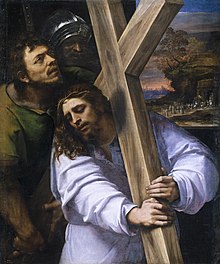
The main sources for his personality and habits are Vasari and surviving letters, mostly to and from Michelangelo. Vasari knew Sebastiano, but probably not very well; although he had been compiling material for some time, the first edition ofhisLivesdid not appear until 1550, after Sebastiano's death, and it is not clear if he had specifically discussed the biography with Sebastiano. He knew Michelangelo rather better, and his description of Sebastiano is probably heavily influenced by the hostile attitude Michelangelo had towards Sebastiano after 1534. Vasari takes up much of hisLifebemoaning Sebastiano's supposed indolence and neglect of his artistic talent for a comfortable and convivial life, at least after 1531.[39]
Vasari says that in later life he lived in a fine house near thePiazza del Popolo,keeping a very good table, and often entertaining regular friends as well as visitors. He says he was always cheerful and humorous, and very good company. He became red-faced and rather fat, as the bearded portrait in theLivessuggests.[39]
As described above, he had become close to Michelangelo by about 1515. Though they eventually fell out, few people were able to remain on good terms with Michelangelo for a period of nearly twenty years. In 1519 Michelangelo became godfather to Sebastiano's first son, Luciano, after which Sebastiano addressed his letters to "My dearestcompare"(" godfather ").[48]The relationship suffered a dip in 1520 when Sebastiano asked Michelangelo to write toCardinal Bibbiena,a close friend ofPope Leo X,recommending Sebastiano for projects in the Vatican after Raphael's death. Michelangelo sent the letter a month or so later, which Sebastiano presented to the cardinal, without reading it. The letter was in very flippant terms, and Sebastiano complained that it became "practically the only topic of conversation at the Palace, and it makes everyone laugh".[49]Nor did it work in getting Vatican commissions.
In 1521 he acted as Michelangelo's agent in the installation of theRisen ChristorCristo della Minervain Rome, which was botched by the assistant Michelangelo had sent.[50]From 1525 there is a draft for an emotional letter by Michelangelo passing on praise for Sebastiano by one "Captain Cuio", who he had dined with.[51]In 1531 Sebastiano writes a despondent letter describing how "I still don't feel I am the same Bastiano that I was before the Sack; I still don't feel in my right mind."[52]The relationship never recovered from the argument over theLast Judgementin 1534, described above.
Selected works
[edit]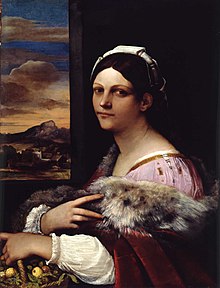
- Venetian period
- Judgement of Solomon,Kingston Lacy,c. 1505–1510, unfinished
- Altarpiece inSan Giovanni Grisostomo, Venice(c. 1509)
- Organ-shutters ofSan Bartolomeo, Venice,nowGallerie dell'Accademia,Venice
- Portrait of a Young Woman as a Wise Virgin(1510)National Gallery of Art,Washington
- SalomeorJudith,1510,National Gallery,London
- Roman period
- Polyphemus(1511)– fresco,Villa Farnesina,Rome
- The Metamorphosis(1511)– fresco,Villa Farnesina,Rome
- Christ Carrying the Cross,c. 1513–14,Prado
- Martyrdom of St. Agatha–Palazzo Pitti,Florence
- Portrait of a Man(c. 1515)– Oil on poplar, 115 x 94 cm,Museum of Fine Arts,Budapest
- Portrait of a Girl(c. 1515)– Oil on wood, 52,5 x 42,8 cm,Museum of Fine Arts,Budapest
- Portrait of a Warrior(c. 1515)
- Cardinal Bandinello Sauli, His Secretary, and Two Geographers(1516)National Gallery of Art,Washington
- Christ descending into Limbo–Prado Museum,Madrid[1],1516
- Transfiguration,Flagellation,saints and prophetsSan Pietro in Montorio,Rome,1516–1524
- A Prophet Addressed by an Angel(1516–17)National Gallery of Art,Washington
- Pietà(c. 1517)– Panel painting, Museo Civico,Viterbo,Italy
- The Raising of Lazarus(1519)National Gallery,London
- Hoy Family(c. 1520)Burgos Cathedral
- Portrait of a Humanist(1520)National Gallery,Washington D.C.[2]
- Portrait of Andrea Doria(1526)Galleria Doria Pamphilj,Rome
- Portrait ofPope Clement VII(half-length, about 1526)Museo di Capodimonte,Naples
- Portrait ofClement VII(with beard, c. 1531)– Oil on Slate 105.4 x 87.6 cmGetty Museum,Los Angeles[3]
- Portrait head of Clement VII on slate, c. 1531,Museo di Capodimonte,Naples
- Birth of the Virgin– Oil on peperino,Santa Maria del Popolo,Rome,never finished
- Christ Carrying the Cross(1535–1540)– Oil on slate, 157 x 118 cm,Museum of Fine Arts,Budapest
- A Lady as Saint Agatha,after 1530, as signed with "F." for "Frate". Probably 1540s,National Gallery,London
- Visitation,originallySanta Maria della Pace,Rome, unfinished with 3 fragments nowAlnwick Castle,1540s
Notes
[edit]- ^Steer, 92–94
- ^Gould, 241; Lucco
- ^Jones & Penny, 183
- ^abcdefghiLucco
- ^Hirst, 209; Lucco; Vasari
- ^abLucco; Vasari
- ^Freedberg, 141
- ^Steer, 90; Gould, 242; New, 33
- ^Hirst, 210–211, 211 quoted; Lucco, giving dates different by a few years, "c. 1505.... probably abandoned by Sebastiano some time before 1507"; Freedberg, 142–143, placing it in 1508.
- ^Hirst, 210; Steer, 92 (quoted); Lucco
- ^Lucco, quoted; Freedberg, 143
- ^Steer, 92–93, 93 quoted
- ^the full set
- ^abcFreedberg, 111
- ^Freedberg, 109–111
- ^Lucco; for the rather uncertain sequence of these works, see Jones & Penny, 93. Vasari says that theGalateawas earlier than thePolyphemus,but this may be wrong.
- ^Lucco; Freedberg, 111
- ^Freedberg, 113, quoted; Vasari says there was a drawing.
- ^M&S, 14
- ^Freedberg, 113
- ^M&S, 56–58
- ^Lucco; Freedberg, 115–116
- ^Vasari; Lucco; M&S, "Room 5"
- ^M&S, before 60; see further: J. Juncic: "Joachimist Prophecies in Sebastiano del Piombo’s Borgherini Chapel and Raphael’s Transfiguration",Journal of the Warburg and Courtauld Institutes,li (1988), pp. 66–84
- ^M&S, 19
- ^M&S, 20
- ^abM&S, 39
- ^Freedberg, 116; Lucco
- ^Jones and Penny, 239; Lucco
- ^M&S, 68, 69
- ^Jones and Penny, 88
- ^Lucco; Freedberg, 225–228
- ^abGould, 247; Lucco
- ^Vasari; Lucco
- ^M&S, 72; Lucco
- ^Sistine, 178; Vasari covers this in hislife of Sebastiano
- ^Vasari,"Life of Sebastiano del Piombo"(near the end)
- ^Freedberg, 226; M&S, 70–72; Lucco
- ^abcVasari
- ^Dunkerton, J., Howard, H. "Sebastiano del Piombo'sRaising of Lazarus:A History of Change ", pp. 33–44, 36 quoted, 2009,National Gallery Technical Bulletin,Vol 30, pp 26–51,online text
- ^M&S, 8
- ^Lucco; M&S, 61
- ^M&S, 35
- ^Lucco; M&S, 41, 42 etc.
- ^British Museum collection database,1935,0713.2, "Four standing women; one in foreground with a bowl balanced on her head,....", a study for the lateVisitationin Sta Maria della Pace.
- ^Freedberg, 116
- ^M&S, 11
- ^M&S, 29, 30
- ^M&S, 31, 32 quoted
- ^M&S, 55
- ^M&S, 66
- ^M&S, 67
References
[edit]- Freedberg, Sydney J.Painting in Italy, 1500–1600,3rd edn. 1993, Yale,ISBN0300055870
- Hirst, Michael in Jane Martineau (ed),The Genius of Venice, 1500–1600,1983, Royal Academy of Arts, London.
- Gould, Cecil,The Sixteenth Century Italian Schools,National Gallery Catalogues, London 1975,ISBN0947645225
- Roger Jones andNicholas Penny,Raphael,Yale, 1983,ISBN0300030614
- Lucco, Mauro, "Sebastiano del Piombo",Grove Art Online,Oxford Art Online. Oxford University Press. Web. 1 Apr. 2017.subscription required
- "M&S": Exhibition handlist with captions for "Michelangelo & Sebastiano", 2017, National Gallery. Refs to catalogue numbers, or, if stated, sections.
- "Sistine": Pietrangeli, Carlo, et al.,The Sistine Chapel: The Art, the History, and the Restoration,1986, Harmony Books/Nippon Television,ISBN051756274X
- Steer, John,Venetian painting: A concise history,1970, London: Thames and Hudson (World of Art),ISBN0500201013
- Vasari,"Life of Sebastiano del Piombo"
Further reading
[edit]- Hirst, Michael,Sebastiano del Piombo,1981, Oxford UP
- Matthias Wivel, Paul Joannides, Costanza Barbieri,Michelangelo & Sebastiano,2017, National Gallery Company Ltd.,ISBN9781857096088
- Rossetti, William Michael(1911)..Encyclopædia Britannica.Vol. 24 (11th ed.). pp. 567–568.
- Sebastiano del Piombo, 1485–1547,exh. cat. by C. Strinati and B. W. Lindemann, 2008, Rome, Palazzo Venezia/Berlin, Gemäldegalerie
- Strinati C.,Sebastiano del Piombo 1485–1547,24 ORE Cultura, Milano 2008,ISBN978-88-7179-576-8
External links
[edit]![]() Media related toSebastiano del Piomboat Wikimedia Commons
Media related toSebastiano del Piomboat Wikimedia Commons
- Michelangelo & Sebastiano,exhibition to 25 June 2017, National Gallery, London
- Sebastiano Luciani – La Piedad – Fundación Casa Ducal de Medinaceli

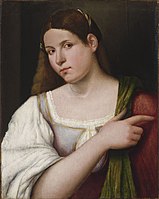
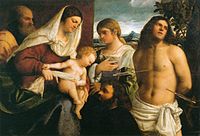
![Saint Louis of Toulouse, from the inside of the organ-shutters of San Bartolomeo, Venice.[13]](https://upload.wikimedia.org/wikipedia/commons/thumb/0/08/Accademia_-_San_Ludovico_da_Tolosa_di_Sebastiano_del_Piombo.jpg/94px-Accademia_-_San_Ludovico_da_Tolosa_di_Sebastiano_del_Piombo.jpg)





![Descent into Limbo, 1516, left wing of a triptych.[25]](https://upload.wikimedia.org/wikipedia/commons/thumb/e/ea/Bajada_de_Cristo_al_Limbo_%28Sebastiano_del_Piombo%29.jpg/101px-Bajada_de_Cristo_al_Limbo_%28Sebastiano_del_Piombo%29.jpg)
![The Hermitage Museum Lamentation of Jesus, 1516, centre part of the triptych.[26]](https://upload.wikimedia.org/wikipedia/commons/thumb/3/3b/Piombo_%28Llanto_por_Cristo_muerto%29.jpg/151px-Piombo_%28Llanto_por_Cristo_muerto%29.jpg)



![Madonna with the Veil (original version, Olomouc), c. 1525.[27]](https://upload.wikimedia.org/wikipedia/commons/thumb/3/3c/Madona_s_rou%C5%A1kou%2C_Sebastiano_del_Piombo_%28cropped%29.jpg/152px-Madona_s_rou%C5%A1kou%2C_Sebastiano_del_Piombo_%28cropped%29.jpg)
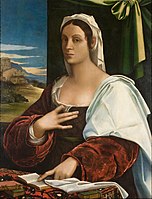


![A Lady as Saint Agatha, after 1530, as signed with "F." for "Frate". Probably 1540s.[33]](https://upload.wikimedia.org/wikipedia/commons/thumb/7/77/Sebastiano_del_Piombo_007.JPG/165px-Sebastiano_del_Piombo_007.JPG)